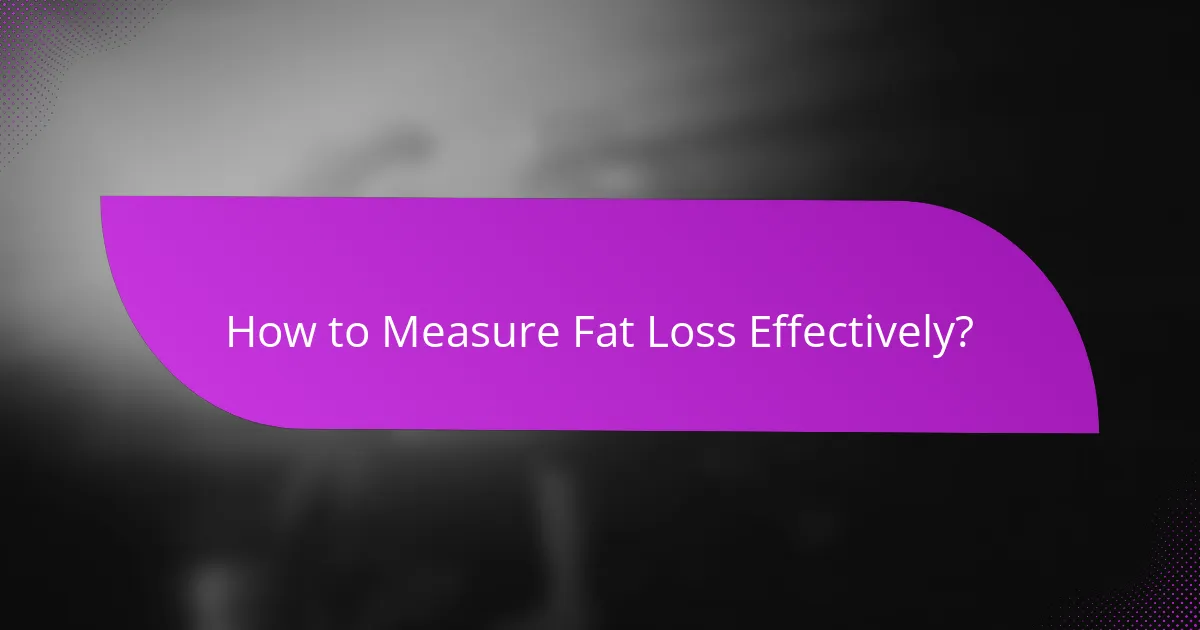Understanding the differences between muscle gain and fat loss is crucial for achieving specific fitness goals. While muscle gain emphasizes increasing lean body mass through targeted nutrition and strength training, fat loss focuses on reducing body fat percentage, often requiring distinct measurement techniques. This article explores effective methods for assessing muscle development and fat loss, providing valuable insights for tracking progress and optimizing results.

What Are the Best Techniques for Muscle Gain Measurement?
The best techniques for measuring muscle gain focus on assessing changes in body composition, strength levels, and training progress. These methods provide insights into muscle development and help track effectiveness over time.
Body Composition Analysis
Body composition analysis evaluates the proportion of muscle, fat, and other tissues in the body. Common methods include dual-energy X-ray absorptiometry (DEXA), bioelectrical impedance analysis (BIA), and skinfold measurements. Each technique varies in accuracy and cost, with DEXA being among the most precise but also more expensive.
When utilizing body composition analysis, aim to measure changes over time rather than focusing on a single reading. Regular assessments can help identify trends in muscle gain and fat loss, guiding adjustments to your training and nutrition strategies.
Strength Testing
Strength testing involves assessing maximum strength levels through exercises like the bench press or squat. One-repetition maximum (1RM) tests are commonly used, but submaximal tests can also provide valuable insights. Tracking improvements in strength can indicate muscle gain, as increased strength typically correlates with muscle hypertrophy.
To effectively measure strength, consider testing every 4-6 weeks and record your results. This will help you monitor progress and make necessary adjustments to your workout regimen.
Progressive Overload Tracking
Progressive overload tracking focuses on systematically increasing the demands placed on your muscles during workouts. This can be achieved by increasing weights, repetitions, or workout volume. Keeping a detailed log of your workouts helps ensure you are consistently challenging your muscles, which is essential for muscle growth.
To implement progressive overload, set specific goals for each training session. For example, aim to increase the weight lifted by 2.5-5% or add an extra repetition each week. Avoid plateaus by varying your exercises and incorporating different training modalities.

How to Measure Fat Loss Effectively?
Measuring fat loss effectively involves tracking specific metrics that indicate changes in body composition. The most reliable methods include caloric deficit tracking, body fat percentage assessments, and waist circumference measurements.
Caloric Deficit Tracking
Caloric deficit tracking is essential for fat loss, as it measures the difference between calories consumed and calories burned. To achieve fat loss, aim for a daily deficit of around 500 to 1000 calories, which can lead to a sustainable weight loss of about 0.5 to 1 kg per week.
Use apps or food diaries to log your meals and activities. Be mindful of hidden calories in beverages and snacks, which can easily derail your efforts. Regularly reassess your caloric needs as your weight changes.
Body Fat Percentage Assessment
Assessing body fat percentage provides a clearer picture of fat loss than weight alone. Methods include skinfold calipers, bioelectrical impedance scales, and DEXA scans, each varying in accuracy and cost.
For practical home assessments, consider using bioelectrical impedance scales, which are widely available and user-friendly. Aim for a body fat percentage reduction of 1-2% per month for healthy progress.
Waist Circumference Measurement
Waist circumference measurement is a straightforward way to monitor fat loss, particularly visceral fat, which is linked to health risks. Use a flexible measuring tape around the narrowest part of your waist, ideally after exhaling.
A waist measurement of over 94 cm for men and 80 cm for women is generally considered high risk. Track this measurement monthly to gauge progress, aiming for a reduction of a few centimeters over time as you lose fat.

What Are the Key Differences Between Muscle Gain and Fat Loss?
Muscle gain and fat loss are two distinct fitness goals that require different approaches in terms of nutrition, exercise, and physiological responses. While muscle gain focuses on increasing lean body mass, fat loss aims to reduce body fat percentage, often leading to different dietary and workout strategies.
Physiological Responses
The body reacts differently to muscle gain and fat loss. Muscle gain involves hypertrophy, where muscle fibers increase in size due to resistance training and adequate protein intake. In contrast, fat loss triggers a calorie deficit, prompting the body to utilize stored fat for energy, which can lead to a decrease in overall body weight.
Understanding these physiological responses is crucial. For muscle gain, the body requires sufficient recovery time and nutrients to repair and build muscle tissue. For fat loss, maintaining a consistent calorie deficit while ensuring nutrient intake is vital to preserve lean muscle mass.
Nutrition Strategies
Nutritional approaches vary significantly between muscle gain and fat loss. For muscle gain, a diet rich in protein, healthy fats, and complex carbohydrates is essential, often requiring a caloric surplus. Aim for about 1.6 to 2.2 grams of protein per kilogram of body weight to support muscle growth.
Conversely, fat loss typically necessitates a caloric deficit, focusing on whole foods that are nutrient-dense yet lower in calories. Prioritize lean proteins, vegetables, and whole grains while limiting sugars and saturated fats. Tracking macronutrients can help maintain the right balance for either goal.
Workout Regimens
Workout routines differ based on the objective of muscle gain or fat loss. Strength training is fundamental for muscle gain, with a focus on progressive overload through heavier weights and lower repetitions. Aim for 3-5 sessions per week, incorporating compound movements like squats and deadlifts.
For fat loss, a combination of strength training and cardiovascular exercise is effective. High-Intensity Interval Training (HIIT) can be particularly beneficial, as it burns calories while preserving muscle. Aim for at least 150 minutes of moderate aerobic activity or 75 minutes of vigorous activity weekly, alongside strength training sessions.

How Do Nutrition Plans Differ for Muscle Gain vs. Fat Loss?
Nutrition plans for muscle gain and fat loss differ primarily in their macronutrient composition and meal timing strategies. Muscle gain requires a caloric surplus with a focus on protein and carbohydrates, while fat loss emphasizes a caloric deficit with a higher protein intake to preserve muscle mass.
Macronutrient Ratios
For muscle gain, a common macronutrient ratio is approximately 40% carbohydrates, 30% protein, and 30% fats. This balance supports energy needs for workouts and muscle recovery. In contrast, a fat loss plan often shifts to around 40% protein, 30% fats, and 30% carbohydrates, prioritizing protein to maintain muscle while reducing overall caloric intake.
Adjustments may be necessary based on individual responses, activity levels, and specific goals. For example, those engaging in intense strength training might require higher carbohydrates for energy, while those focusing on endurance might benefit from a different balance.
Meal Timing Strategies
Meal timing can play a significant role in both muscle gain and fat loss. For muscle gain, consuming protein-rich meals every 3-4 hours can help maximize muscle protein synthesis. Including carbohydrates around workouts can enhance performance and recovery.
In a fat loss strategy, spacing meals to prevent excessive hunger and maintaining steady energy levels is crucial. Some individuals find success with intermittent fasting, which can help control caloric intake while still allowing for nutrient-dense meals during eating windows.

What Role Do Supplements Play in Muscle Gain and Fat Loss?
Supplements can support both muscle gain and fat loss, but their effectiveness often depends on individual goals and dietary habits. While some supplements enhance performance and recovery, others may aid in fat metabolism, making informed choices essential.
Protein Supplements
Protein supplements, such as whey or casein, are popular for muscle gain as they provide essential amino acids that promote muscle repair and growth. Consuming protein supplements post-workout can enhance recovery and support muscle synthesis, especially when dietary protein intake is insufficient.
When considering protein supplements, aim for a daily intake of around 1.6 to 2.2 grams of protein per kilogram of body weight, depending on your activity level. Be cautious of excessive consumption, as it may lead to digestive issues or unnecessary caloric intake.
Fat Burners
Fat burners are supplements designed to enhance fat loss by increasing metabolism or promoting fat oxidation. Common ingredients include caffeine, green tea extract, and L-carnitine, which may help boost energy levels and improve workout performance.
While fat burners can provide a slight edge in weight loss, they should not replace a balanced diet and regular exercise. It’s crucial to read labels carefully and consult with a healthcare professional, especially if you have underlying health conditions or are taking other medications.

What Are Common Mistakes in Measuring Muscle Gain and Fat Loss?
Common mistakes in measuring muscle gain and fat loss often stem from a lack of understanding of body composition and the impact of water weight. These errors can lead to misleading conclusions about progress and overall health.
Ignoring Body Composition
Focusing solely on weight can obscure the true picture of muscle gain and fat loss. Body composition, which includes the ratio of fat to lean mass, is a more accurate indicator of fitness. For instance, two individuals may weigh the same but have significantly different muscle and fat percentages.
To effectively measure body composition, consider using methods like skinfold calipers, bioelectrical impedance scales, or DEXA scans. These tools provide insights into how much muscle and fat you have, allowing for better tracking of changes over time.
Overlooking Water Weight
Water weight can fluctuate significantly and may misrepresent actual muscle gain or fat loss. Factors such as diet, hydration levels, and hormonal changes can lead to temporary increases or decreases in water retention. For example, consuming high-sodium foods can cause your body to retain more water, affecting scale readings.
To account for water weight, track your measurements over a longer period rather than relying on daily fluctuations. Aim to assess changes weekly or bi-weekly, and consider using a consistent time of day for weighing yourself, ideally after waking up and using the restroom.


